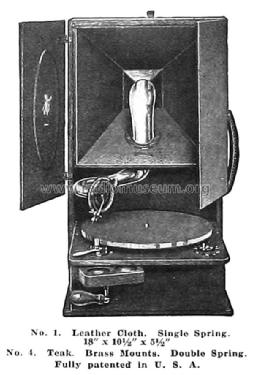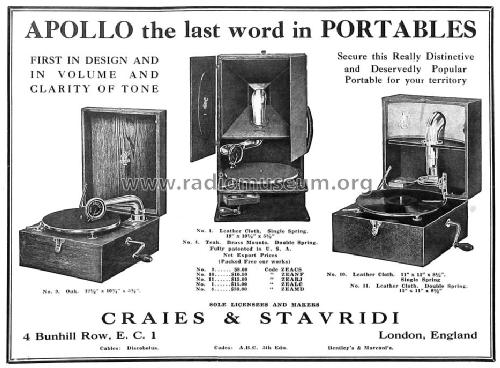Apollo Gramophone No. 1
Apollo (Brand), Craies & Stavridi; Apollo Gramophone Co. Ltd; London
- País
- Gran Bretaña (GB)
- Fabricante / Marca
- Apollo (Brand), Craies & Stavridi; Apollo Gramophone Co. Ltd; London
- Año
- 1920–1922 ??
- Categoría
- Máquina parlante mecánica - gramófono o fonógrafo.
- Radiomuseum.org ID
- 257295
- Gama de ondas
- - no hay
- Tensión de funcionamiento
- Solar / alimentación por manivela.
- Altavoz
- Corneta
- Material
- Cuero/Tela/ Plástico sobre otros materiales
- de Radiomuseum.org
- Modelo: Apollo Gramophone No. 1 - Apollo Brand, Craies &
- Forma
- Sobremesa de cualquier forma, detalles no conocidos.
- Ancho, altura, profundidad
- 10.5 x 18 x 5.5 inch / 267 x 457 x 140 mm
- Anotaciones
-
Portable gramophone with reflex horn for upright operation. Single spring mechanism. Leather cloth, the same model in teak with brass mounts and double spring see No. 4.
Net export price for the USA.
These explanations refer to the color image. The model on the left in the image corresponds to the model in the existing black image alone and the central one in the three models' black image. The model on the right is yet another variation of the Apollo, but very similar to the one on the right in the three model existing black image.
Apollo portables, circa 1920-2. The model on the right is probably the older of the two, although its exact date is not known. Like many portable Apollos, when closed it resembles a Decca and it was perhaps the desire to abandon this bulky, almost cubic shape that led to the folding Apollo of 1921 (left). This model was made of teak and was more pleasant than efficient. Once folded it becomes a precise flat rectangle, easier to transport than the Decca type (the one on the right).
Original description from: “Fonografi e Grammofoni” by Christopher Proudfoot, Italian edition “Silvana Editoriale” 1980.Queste spiegazioni si riferiscono all'immagine a colori. Il modello a sinistra nell'immagine corrisponde al modello nell'immagine da solo e a quello centrale nell'immagine dei tre modelli. Il modello a destra è un'ennesima variazione dell'Apollo, ma molto simile a quello a destra nell'immagine dei tre modelli.
Portatili Apollo, 1920-2 circa. Il modello di destra è probabilmente il più vecchio dei due, benchè non se ne conosca la data esatta. Come molti Apollo portatili, una volta chiuso assomiglia ad un Decca e fu forse il desiderio di abbandonare quest'ingombrante forma quasi cubica che portò all'Apollo pieghevole del 1921 (a sinistra). Questo modello era di teak ed era più gradevole che efficiente. Una volta piegato diventa un preciso rettangolo piatto, più facile da trasportare del tipo Decca (quello di destra).
Descrizione originale da: “Fonografi e Grammofoni” di Christopher Proudfoot. Edizione Italiana Silvana Editoriale, 1980.
- Precio durante el primer año
- 15.00 $
- Mencionado en
- The Talking Machine World, Sep. 15 1925, p.219
- Documentación / Esquemas (1)
- -- Original prospect or advert (From: “Fonografi e Grammofoni” by Christopher Proudfoot, Italian edition “Silvana Editoriale)
- Otros modelos
-
Donde encontrará 13 modelos, 9 con imágenes y 0 con esquemas.
Ir al listado general de Apollo (Brand), Craies & Stavridi; Apollo Gramophone Co. Ltd; London


